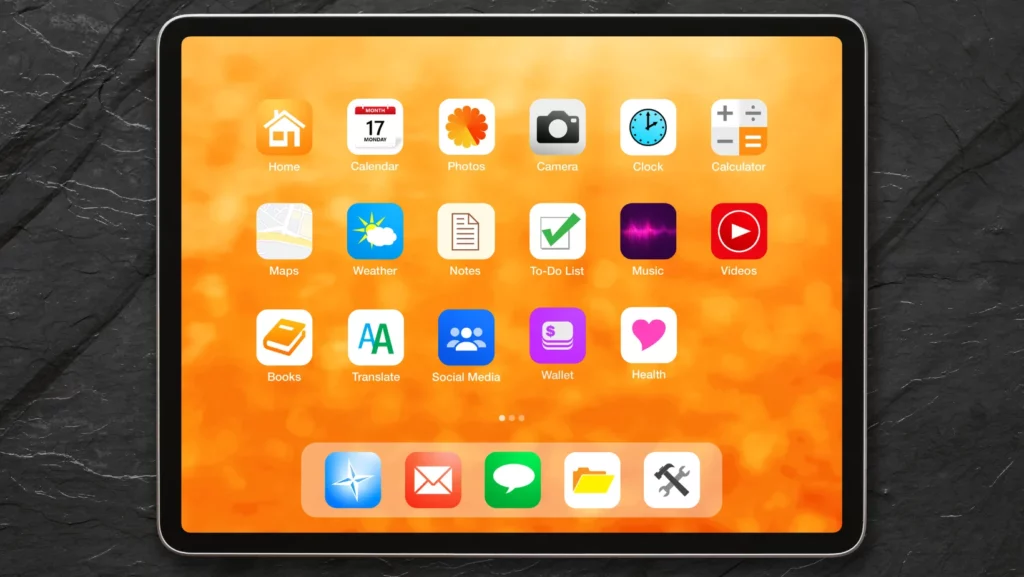In the ever-evolving landscape of modern business, where agility and efficiency are paramount, tablets have emerged as transformative tools, reshaping the way organizations operate and professionals engage with their work. This technological marvel, compact yet powerful, has seamlessly integrated itself into the fabric of business environments, becoming a linchpin for enhanced productivity, collaboration, and mobility.
The role of tablets in business extends far beyond mere portability. With their intuitive interfaces and diverse app ecosystems, tablets empower professionals to break free from traditional work constraints, fostering a dynamic and flexible approach to tasks. In this article, let us explore the symbiotic relationship between tablets and business productivity. Join us on this journey as we dissect the multifaceted impact of tablets on business operations, navigating through their ability to enhance communication, streamline workflows, and redefine the very notion of a workspace.
Ever wondered what it would be like to have your entire office at your fingertips?
Tablets are not just gadgets; they are your passport to a new frontier of efficiency and agility in the business realm. Discover the untapped potential as we unravel the secrets behind how tablets seamlessly blend into your workflow, turning mundane tasks into moments of triumph.
Picture a scenario where every meeting, presentation, or brainstorming session flows effortlessly, thanks to the transformative power of tablets. It’s not just about desire; it’s about craving a workplace where innovation is unbridled, and your business reaches its zenith.
The time to act is now! Embrace the tablet revolution and set your business on a trajectory toward unprecedented productivity!
Did you know?
- Apple’s iPad is the best-selling tablet of all time, with over 400 million units sold since its release in 2010.
- India was the country where tablets were the least popular with only a 2% share of the overall web traffic in the analyzed period.
What is the definition of a tablet?

In the context of computing and technology, a tablet refers to a portable, flat, and typically touchscreen device. It is larger than a smartphone but smaller than a traditional laptop or desktop computer. Tablets are characterized by their slim and lightweight design, and they rely primarily on touch input for user interaction, though they may also support stylus or pen input.
Key features of tablets include the following:
Touchscreen Interface:
Tablets are equipped with a touchscreen display, allowing users to interact with the device by tapping, swiping, and gesturing on the screen.
Portability:
Tablets are designed to be highly portable, making them convenient for on-the-go use. They are generally smaller and lighter than traditional laptops.
App Ecosystem:
Tablets typically run on mobile operating systems (e.g., iOS, Android) and have access to application ecosystems, where users can download and install various apps to enhance functionality.
Multimedia Capabilities:
Tablets often have robust multimedia capabilities, supporting activities such as video playback, gaming, and content consumption.
Long Battery Life:
Due to their energy-efficient designs, tablets usually offer a longer battery life compared to traditional laptops.
Popular examples of tablets include the Apple iPad, Samsung Galaxy Tab, and various models from other manufacturers. Tablets serve a range of purposes, from entertainment and content consumption to productivity and business applications.
What a tablet is used for?
Tablets serve a versatile range of purposes and can be used for various activities. Here are some common uses of tablets:
- Content Consumption:
- Watching movies, TV shows, and videos.
- Streaming music and podcasts.
- Reading e-books, magazines, and newspapers.
- Browsing the internet for news and information.
- Productivity and Business:
- Email communication and management.
- Document creation and editing (word processing, spreadsheets, presentations).
- Project management and collaboration.
- Accessing and editing files stored in the cloud.
- Education:
- E-learning and online courses.
- Interactive educational apps and games.
- Digital textbooks and resources.
- Note-taking during lectures.
- Creative and Design Work:
- Digital art creation and drawing.
- Photo and video editing.
- Graphic design and illustration.
- 3D modeling and animation.
- Communication:
- Video conferencing and virtual meetings.
- Social media interactions.
- Voice and video calls.
- Messaging apps for text communication.
- Entertainment and Gaming:
- Playing games (casual and more advanced).
- Virtual reality (VR) and augmented reality (AR) experiences.
- Interactive storytelling apps.
- Navigation and Travel:
- GPS navigation and maps.
- Travel planning and booking.
- Language translation apps.
- Accessing travel guides and recommendations.
- Health and Fitness:
- Fitness tracking and monitoring.
- Accessing health-related apps and information.
- Guided workouts and exercise routines.
- Reference and Information:
- Online research and reference materials.
- Accessing encyclopedias and dictionaries.
- Learning new skills through tutorial apps.
- Custom Applications:
- Specialized apps for specific industries or professions (e.g., medical, engineering, architecture).
- Custom business applications tailored to specific needs.
The versatility of tablets makes them suitable for a wide range of users and activities, from casual entertainment to professional tasks across various industries.
Tablets as Productivity Catalysts in the Modern Workplace

In today’s dynamic work environment, tablets have emerged as indispensable catalysts for enhancing productivity in the modern workplace. These sleek and portable devices transcend the limitations of traditional office setups, providing professionals with the freedom to work seamlessly from virtually any location. With their mobility as a key asset, tablets empower dynamic workforces by facilitating constant connectivity, enabling employees to stay productive while on the move.
Beyond their role in fostering mobility, tablets redefine how business operates within the confines of conference rooms and boardrooms. Serving as transformative tools in meetings and presentations, tablets streamline communication and enhance collaboration. Their interactive interfaces and versatile applications not only facilitate effective discussions but also bring a new level of engagement to corporate gatherings. This strategic integration of tablets into the fabric of business workflows marks a paradigm shift, catalyzing operational efficiency and offering decision-makers real-time access to critical information, thereby reshaping the very essence of productivity in the contemporary workplace.
Tablets in Meetings and Presentations: Revolutionizing Corporate Communication

In corporate communication, tablets have emerged as catalysts, ushering in a revolution that transforms the landscape of meetings and presentations. These sleek devices redefine the traditional notion of boardroom interactions, introducing a new era of efficiency and engagement. Tablets act as dynamic tools, seamlessly blending into the corporate environment and enhancing communication in once unimaginable ways.
Here are a few samples:
Interactive Engagement:
- Before: Traditional presentations were one-way, lacking active participation.
- Now: Tablets enable interactive engagement, allowing attendees to actively participate by annotating slides, contributing ideas, and fostering collaborative discussions.
Real-time Updates:
- Before: Changes to presentations required pre-meeting preparations.
- Now: Tablets facilitate real-time updates, allowing presenters to adapt content on the fly, ensuring information is always current and relevant.
Collaborative Brainstorming:
- Before: Brainstorming sessions were often limited to whiteboards or flip charts.
- Now: Tablets encourage collaborative brainstorming with digital tools, making it easier for teams to ideate, contribute, and visualize ideas collectively.
Dynamic Content Control:
- Before: Presenters were tied to fixed podiums or laptops.
- Now: Tablets provide dynamic content control, enabling presenters to move freely, control presentations wirelessly, and engage with the audience directly for a more dynamic and impactful delivery.
Enhanced Accessibility:
- Before: Accessibility to presentation materials was limited to printed handouts.
- Now: Tablets enhance accessibility, allowing participants to access presentation materials digitally, fostering a more eco-friendly and efficient approach.
Paperless Meetings:
- Before: Meetings generated significant paper waste through agendas and handouts.
- Now: Tablets contribute to paperless meetings, reducing environmental impact and streamlining the meeting process with digital documents.
Improved Data Security:
- Before: Security concerns with physical documents and data sharing.
- Now: Tablets enhance data security by enabling encrypted digital documents and controlled access, mitigating risks associated with physical materials.
Seamless Remote Participation:
- Before: Remote participation in meetings was often challenging.
- Now: Tablets facilitate seamless remote participation, allowing off-site team members to actively engage in meetings and presentations, fostering inclusivity and collaboration.
Tablets have revolutionized corporate communication in meetings and presentations by introducing interactive, dynamic, and collaborative features, transforming the traditional static approach into a more engaging and efficient process.
Enhancing Business Decision-Making with Tablet Technology

Tablet technology has become a cornerstone in enhancing business decision-making processes, offering a myriad of benefits and advantages that significantly impact organizational effectiveness.
Leveraging tablet technology in business decision-making processes offers a spectrum of advantages such as:
1. Real-Time Data Access:
Tablets empower decision-makers with instant access to real-time data, ensuring that critical information is available at their fingertips. Faster decision-making based on the most up-to-date and relevant information, leading to more informed choices.
2. Portability and Flexibility:
The portability of tablets allows decision-makers to carry their insights wherever they go, fostering flexibility in decision-making. Flexibility in decision-making locations ensures that decisions are not delayed, promoting agility in response to dynamic business environments.
3. Interactive Data Visualization:
Tablets facilitate interactive data visualization, making complex information more digestible and aiding in comprehensive decision analysis. Decision-makers can grasp insights more intuitively, promoting a deeper understanding of trends, patterns, and potential outcomes.
4. Collaborative Decision-Making:
Tablets enable collaborative decision-making by providing a platform for team members to share and discuss insights in real time. Enhanced collaboration fosters collective intelligence, leading to more well-rounded and inclusive decisions.
5. Paperless Decision Processes:
Tablets contribute to a paperless decision-making environment, reducing administrative overhead and environmental impact. Streamlined processes and improved sustainability contribute to overall efficiency and corporate responsibility.
6. Enhanced Security Measures:
Tablets offer robust security features, ensuring the confidentiality and integrity of sensitive decision-related information. Increased data security mitigates risks associated with decision-making, safeguarding the organization’s strategic information.
7. Seamless Integration with Business Systems:
Tablets seamlessly integrate with existing business systems, allowing decision-makers to access data from various sources. A unified view of information enhances decision-makers ability to assess comprehensive insights, promoting more holistic and informed decisions.
8. Improved Communication:
Tablets facilitate efficient communication channels, ensuring decision-makers can easily communicate and disseminate decisions to relevant stakeholders. Clear and timely communication enhances the implementation of decisions, minimizing misunderstandings and improving overall organizational alignment.
Embracing tablets as tools for decision-makers contributes to a more agile, informed, and efficient organizational decision-making landscape.Tablets in Sales and Customer Relationship Management (CRM)
Tablets and Time Management: Boosting Personal and Team Efficiency
Tablets play a crucial role in optimizing time management for both individuals and teams. With their portable and versatile features, these devices contribute to enhanced efficiency in various ways.
- Accessibility on the Go.
- Centralized Organization.
- Collaborative Planning.
- Efficient Task Execution.
- Notifications and Reminders.
- Document Management.
- Time Tracking Tools.
- Integration with Productivity Apps.
- Mobility and Flexibility.
Tablets allow individuals to access their schedules, tasks, and important information from anywhere, promoting flexibility and ensuring that time management tools are readily available on the go. It also serves as a centralized hub for managing calendars, to-do lists, and reminders, providing a streamlined approach to organizing tasks and priorities in one accessible location.
Tablets facilitate collaborative planning by enabling team members to share calendars, coordinate schedules, and collaborate on projects in real time, promoting synchronized efforts and minimizing scheduling conflicts. With intuitive touch interfaces and user-friendly apps, tablets make it easier to navigate through tasks swiftly, allowing individuals to execute activities with speed and precision.
Tablets offer customizable notifications and reminders, helping individuals and teams stay on top of deadlines, meetings, and important milestones, thereby preventing oversights. Tablets support document management systems, making it convenient for individuals and teams to access, edit, and share documents seamlessly, contributing to efficient collaborative work.
Various time-tracking apps available on tablets help individuals monitor how they spend their time, identify productivity patterns, and make informed adjustments to optimize personal and team efficiency. Tablets seamlessly integrate with a variety of productivity apps, from note-taking to project management, offering a comprehensive toolkit that enhances both personal and team-level efficiency. The portability of tablets ensures that time management tools are not confined to desktops, allowing individuals and teams to manage their time efficiently whether in the office, during travel, or in remote work settings.
The Pros and Cons of Using Tablets in Your Business and Productivity

Pros of Using Tablets in Business and Productivity:
- Portability and Mobility: Tablets are highly portable, enabling employees to work from anywhere, fostering flexibility, and enhancing productivity on the go.
- Enhanced Collaboration: Tablets facilitate real-time collaboration through apps and cloud-based tools, promoting seamless communication and teamwork among employees.
- Streamlined Communication: Tablets offer various communication tools, including video conferencing and messaging apps, promoting efficient and instant communication within the organization.
- Versatility in Applications: The vast app ecosystem allows businesses to customize tablets with specialized applications, catering to specific industry needs and enhancing overall productivity.
- Interactive Presentations: Tablets provide a dynamic platform for interactive presentations, improving engagement during meetings and allowing for real-time adjustments to content.
- Paperless Workflow: Tablets contribute to a paperless environment, reducing costs associated with printing and document storage while supporting environmentally friendly practices.
- Efficient Task Management: Task management apps on tablets help individuals and teams organize priorities, set reminders, and stay on top of deadlines, contributing to efficient task execution.
- Improved Accessibility: Tablets offer instant access to information and applications, enhancing overall accessibility to business resources and promoting faster decision-making.
Cons of Using Tablets in Business and Productivity:
- Initial Cost: The upfront cost of purchasing tablets and related accessories can be higher compared to traditional computing devices.
- Limited Processing Power: Tablets may have limited processing power compared to laptops or desktops, potentially impacting the performance of resource-intensive applications.
- Dependency on Touch Input: Tablets primarily rely on touch input, which may not be suitable for all tasks, and some users may prefer physical keyboards and mice for certain activities.
- Security Concerns: Tablets may pose security challenges, especially if not properly managed, as they are more susceptible to loss or theft, potentially compromising sensitive business data.
- Compatibility Issues: Compatibility with certain business software or legacy systems may be a challenge, requiring additional efforts for integration or customization.
- Multitasking Limitations: While multitasking is possible on tablets, it may not be as seamless as on traditional computers, affecting the efficiency of users who require extensive multitasking capabilities.
- Limited Screen Real Estate: The smaller screen size of tablets may be a limitation for tasks that require extensive visualization or detailed data analysis.
- Device Fragility: Tablets are generally more fragile than rugged laptops or desktops, making them more susceptible to damage in certain work environments.
While tablets offer numerous advantages for business and productivity, it’s crucial to weigh these benefits against potential drawbacks to make informed decisions based on specific organizational needs and requirements.
Frequently Asked Questions About The Role of Tablets in Business and Productivity
Q: How can tablets enhance business productivity?
A: Tablets enhance business productivity through their portability, facilitating work on the go, efficient communication tools, collaboration apps, and access to a wide range of productivity applications tailored to specific business needs.
Q: What role do tablets play in improving workplace flexibility?
A: Tablets enable workplace flexibility by allowing employees to work from various locations. With their mobility and versatile applications, tablets contribute to a more flexible work environment, accommodating remote work and on-the-go productivity.
Q: How do tablets streamline communication in a business setting?
A: Tablets streamline communication through various apps, including email, messaging, and video conferencing. They facilitate real-time collaboration, ensuring efficient communication among team members and stakeholders.
Q: Can tablets be used effectively for presentations in a business context?
A: Yes, tablets are highly effective for business presentations. Their interactive interfaces and multimedia capabilities enhance presentations, allowing for dynamic engagement, real-time adjustments, and more impactful communication of ideas.
Q: How do tablets contribute to paperless workflows in businesses?
A: Tablets contribute to paperless workflows by supporting digital documentation, e-signatures, and cloud-based storage solutions. This reduces reliance on physical paperwork, leading to improved organization, cost savings, and a more environmentally sustainable approach to business operations.
Final Thoughts
In the dynamic landscape of business, tablets play a pivotal role in fostering flexibility and mobility. No longer confined to desks, professionals armed with tablets can conquer tasks on the go, transforming mundane work routines into adventures of productivity. From bustling boardrooms to cozy coffee shops, the tablet is the emblem of a workplace that transcends physical boundaries.
In the quest for paperless workflows, tablets emerge as green warriors, reducing our reliance on paperwork and contributing to a more sustainable work ecosystem. The ability to access real-time data, collaborate seamlessly, and make informed decisions on the fly positions tablets as indispensable tools in the pursuit of enhanced productivity. They are not just devices; they are facilitators of a more connected and engaged work environment.

